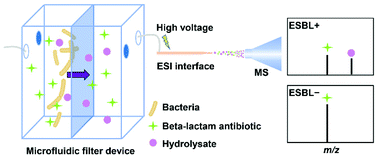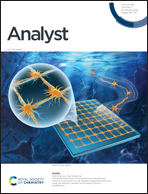Microfluidic filter device coupled mass spectrometry for rapid bacterial antimicrobial resistance analysis†
Abstract
The problem of antimicrobial resistance (AMR) is becoming increasingly serious. Bacteria producing extended spectrum beta-lactamase (ESBL), which can hydrolyze beta-lactam antibiotics, are among the most important drug resistant bacteria. Rapid AMR analysis methods are essential for identifying antibiotic resistant bacteria, which is of significant positive value to the clinical therapy of infectious disease. We developed a platform which integrates a sandwich microfluidic filter device with electrospray ionization mass spectrometry (ESI-MS). Bacterial cells were loaded in the sandwich microfluidic chip and antibiotic drugs were injected to pass through the blocked bacterial cells. By online ESI-MS analysis of the antibiotic drugs and their hydrolysis products, the AMR of the bacteria can be assessed within 30 minutes. Four Escherichia coli strains, namely two ESBL-positive and two ESBL-negative, were successfully discriminated using ampicillin and the third generation cephalosporin ceftriaxone. Considering the simplicity and high efficiency of the assay, the microfluidic chip integrated online ESI-MS system is promising in the rapid clinical diagnosis of ESBL-producing bacteria.

- This article is part of the themed collection: Analyst Recent HOT articles


 Please wait while we load your content...
Please wait while we load your content...